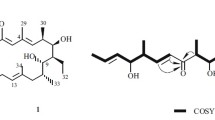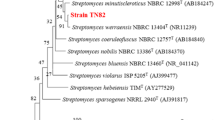Abstract
Nine fungal strains of Dichotomomyces cejpii were studied for their ability to produce antibiotic metabolites. It was found that they produced secondary exo- and endo metabolites with antimicrobial activity against Gram-negative and Gram-positive bacteria, yeasts and moulds and with a toxic effect against animal organs in vitro. Detailed chemical characterization of these active principles need to be carried out.
Similar content being viewed by others
References
Scott DB. Dichotomomyces cejpii (MIL'KO) comb. nov. Trans Br Mycol Soc 1970; 55: 313–316.
Ueda S. A mycofloral study on brackish water sediments in Nagasaki, Japan. Trans Mycol Soc Japan 1980a; 21: 108–112.
Ueda S. A mycofloral study on river sediments in Nagasaki, Japan. Trans Mycol Soc Japan 1980b; 21: 495–504.
Jesenská Z, Piecková E, Bernát D. Heat resistant fungi in the soil. Int J Food Microbiol 1992; 16: 209–214.
Jesenská Z, Piecková E, Bernát D. Heat resistance of fungi from soil. Int J Food Microbiol 1993; 19: 187–192.
Piecková E, Bernát D, Jesenská Z. Heat resistant fungi isolated from soil. Int J Food Microbiol 1994; 22: 297–299.
Piecková E, Jesenská Z. Dichotomomyces cejpii – some characteristics of strains isolated from soil in the Slovak Republic. Czech Mycol 1997; 49: 229–237.
Jesenská Z, Piecková E. The effects of fungicidal agrochemicals on heat-resistant fungi in vitro. Biologia, Bratislava 1994; 49: 325–328.
Ando K, Tamura G, Arima K. A new antibiotic, 1-(p-hydroxyphenyl)-2,3-diisocyano-4-(p-methoxyphenyl)-buta-1,3-diene. II. J Antibiotics 1968; 31: 587–591.
Ando K, Suzuki S, Takatsuki A, Arima K, Tamura G. A new antibiotic, 1-(p-hydroxyphenyl)-2,3-diisocyano-4-(pmethoxyphenyl)-buta-1,3-diene. I. J Antibiotics 1968; 31: 582–586.
Takatsuki A, Tamura G, Arima K. New antiviral antibiotics: xanthocillin X mono-and dimethylether, and methoxyxanthocillin X dimethylether. II. J Antibiotics 1968; 31: 676–680.
Kitahara N, Endo A. Xanthocillin X monomethyl ether, a potent inhibitor of prostaglandin biosynthesis. J Antibiotics 1981; 34: 1556–1561.
Piecková E, Jesenská Z. Toxinogenicity of heat-resistant fungi detected by a bio-assay. Int J Food Microbiol 1997; 36: 227–229.
Jesenská Z, Bernát D. Effects of mycotoxins on in vitro movement of tracheal cilia from one-day-old chickens. Folia Microbiol 1994; 34: 155–158.
Nair PKC, Colwell WM, Edds GT, Cardeilhac PT. Use of tracheal cultures for bioassay of aflatoxin. JAOAC 1970; 53: 1258–1263.
Homans AL, Fuchs A. Direct bioautography on thin-layer chromatograms as a method for detecting fungitoxic substances. J. Chromatogr 1970; 51: 327–329.
Author information
Authors and Affiliations
Rights and permissions
About this article
Cite this article
Piecková, E., Roeijmans, H. Antibiotic secondary metabolites of Dichotomomyces cejpii . Mycopathologia 146, 121–126 (1999). https://doi.org/10.1023/A:1007034913377
Issue Date:
DOI: https://doi.org/10.1023/A:1007034913377




